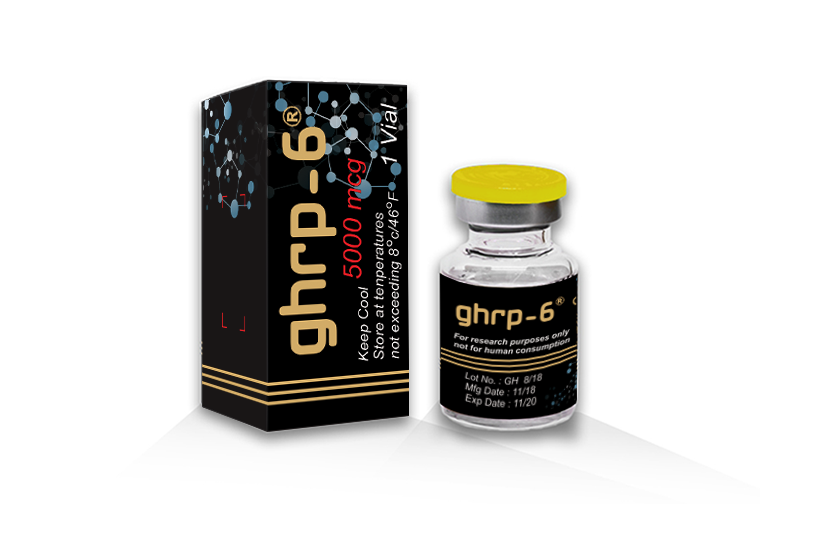GHRP-6
All the information below is strictly for research purposes only. Under no circumstance should this chemical be used for human consumption.
Formula: C46H56N12O6
Molecular weight: 873.01
Chain: His-D-Trp-Ala-Trp-D-Phe-Lys-NH2
CAS: 87616-84-0
Peptide purity: 99.0%(HPLC)
GHRP-6 is a Growth hormone Releasing Peptide containing 6 amino acids. It is a synthetic metenkephalin analog that includes unnatural D-amino acids, developed for gh releasing activity and referred to as gH secretagogues. Recent studies published in The Journal of Clinical Endocrinology and Metabolism in normal mice administered with GHRP-6 displayed significant levels of body composition, glucose metabolism, muscle growth, cardiac and memory function.
Growth Hormone Releasing Peptide 6 has a molecular mass of 873.014 and a molecular formula C46H56N12O6. GHRP-6 does not act at the receptor of GHRP but rather at the gH secretagogue instead, referred to as the ghrelin receptor. GH secretagogues differs from exogenous rHGH in their effects, specifically in the fact that endogenous gH contains all 5 isoforms of growth hormone as opposed to exogenous which contains only the 20 kilodalton isoform. By stimulating the secretion of gH studies are showing the ability of GHRP-6 to lower adiposity (fat) and promote lean body mass. It is being considered an effective anti-inflammatory along with having a positive effect on the liver. This compound is fairly new and still has much research ahead over the next few years as scientists are hoping to gain a better understanding of GHRP-6.
GHRP-6 is a peptide in the growth factor family. It has strong effect on the release of Growth Hormone (GH). Its main use is to promote food intake by stimulating hunger and aid in energy metabolism. It can be used in the treatment of GH deficiency as well as cachexia, eating disorders and obesity. The major side effect accompanied by the use of GHRP-6 is a significant increase in appetite due to a stimulating the release of Ghrelin
GHRP-6 is a true hGH secretagogue so will interact with the receptors on the pituitary and hypothalamus glands. Acting differently than GHRH, GHRP-6 and other growth hormone releasing peptides stimulate the hGH secretagogue receptor (called the Ghrelin receptor) in a pulsatile manner as opposed to the GHRH receptor. Trials on this class of drugs began in the 1990s, and according to 1995 research based on animal reactions, there was a claim that GHRP-6 is more efficient than GHRH, the original version, and it appears the hypothalamus is the primary target.
The drug is a man-made analog met-enkephaline that contains D- amino acids that are not naturally occurring. This structure and the ability to stimulate synthesis of hormones needed for growth allows it to transform into a GH-secretagogue. Research in animal tests has also shown that the compound has properties that are anti-inflammatory and protective of the liver. a peptide which is released naturally in the lining of the stomach and increases hunger and gastric emptying.
GHRP-6 causes stimulation of the anterior pituitary gland which ultimately causes an increase in GH release. Since GHRP-6 acts directly on the feedback loop which signals the inhibition of GH release, when natural GH secretion has been inhibited by long term synthetic use, GHRP-6 can be used to re-stimulate the natural production of GH. GHRP-6 also affects the central nervous system, by protecting neurons as well as increasing strength in a way very similar to the way certain steroids in the Dihydrotestosterone family do.
Benefits of increased Growth Hormone levels through GHRP-6 stimulation include: an increase in strength, muscle mass and body fat loss, rejuvenation and strengthening of joints, connective tissue and bone mass. Enhanced GH secretion also leads to the liver secreting more IGF-1 (Insulin-Like Growth Factor 1), which is thought to be the primary anabolic mechanism of action for Growth Hormone.
A study done in 2011 showed that GHRP-6 has broad potential use in growth, production and immunity in animals.
WARNING This product is a very potent peptide. This product is NOT for human use and can be harmful if ingested. This product is for research/laboratory use only. This product is NOT in a sterile solution and is NOT to be injected. This product should only be handled by licensed, qualified professionals. This product is not a drug, food, or cosmetic and should not be misbranded, misused or mislabeled as a drug, food or cosmetic.
Chemical and other safety information:
|
H-statements (GHS/CLP): |
P-statements (GHS/CLP): |
|---|---|
|
H302:Harmful if swallowed. |
P102:Keep out of reach of children. |
|
H315:Causes skin irritation |
P232:Protect from moisture. |
|
H319:Causes serious eye irritation. |
P235:Keep cool. |
|
H332:Harmful if inhaled. |
P261:Avoid breathing dust/fume/gas/mist/vapours/spray. |
|
P264:Wash hands thoroughly after handling. |
|
|
P301+P312:IF SWALLOWED: Call a POISON CENTER or doctor/physician if you feel unwell. |
|
|
P302+P352:IF ON SKIN: Wash with plenty of soap and water. |
|
|
P301+P330+P331:IF SWALLOWED: rinse mouth. Do NOT induce vomiting. |
|
|
P332+313:If skin irritation occurs: Get medical advice/attention. |
|
|
P411+235:Store at temperatures not exceeding 8°C/46°F. Keep cool |
The latter article is intended for educational / informational purposes only. THIS PRODUCT IS INTENDED AS A RESEARCH PEPTIDE ONLY. This designation allows the use of research peptides strictly for in vitro testing and laboratory experimentation only. Bodily introduction of any kind into humans or animals is strictly forbidden by law.

